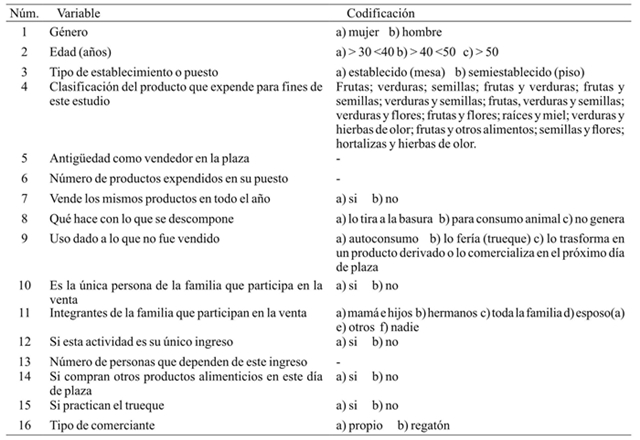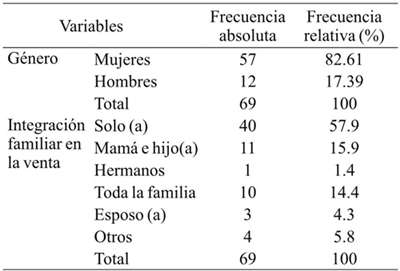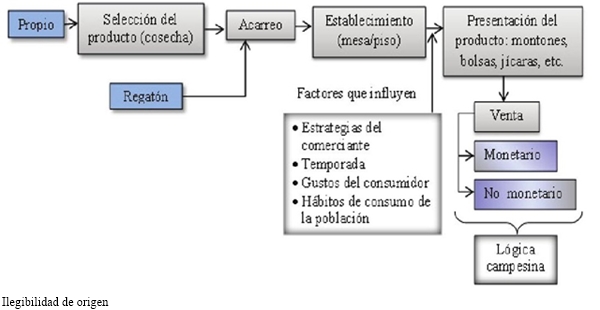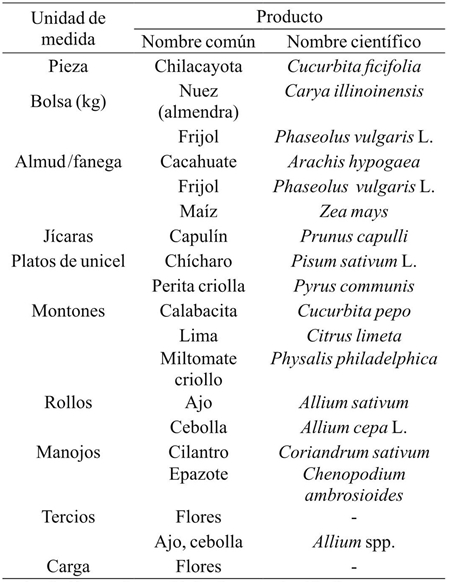Serviços Personalizados
Journal
Artigo
Indicadores
-
 Citado por SciELO
Citado por SciELO -
 Acessos
Acessos
Links relacionados
-
 Similares em
SciELO
Similares em
SciELO
Compartilhar
Revista mexicana de ciencias agrícolas
versão impressa ISSN 2007-0934
Rev. Mex. Cienc. Agríc vol.8 no.4 Texcoco Jun./Jul. 2017
https://doi.org/10.29312/remexca.v8i4.15
Articles
Marketing of agroalimentary products at the “día de plaza” in southern México
1Maestría en Ciencias en Productividad de Agroecosistemas-Instituto Tecnológico del Valle de Oaxaca. Ex Hacienda de Nazareno, Xoxocotlán, Oaxaca, México. Tel. 01(951) 5170788. CP. 71230. (guzk87@hotmail.com; judithruizl@hotmail.com; giscampos@hotmail.com; geraro65@gmail.com; jenriquezdelvalle@yahoo.com).
“Las plazas” symbolize a biocultural heritage, where merchants from different parts come to sell native products of the region. It is a place on a determined day of the week where it is possible to know, interact and preserve part of the culture and way of life of the population. The objective of this research was to describe marketing practices around local food products in the “día de plaza” of Villa de Zaachila, Oaxaca, México. Sampling was directed, surveys and interviews were applied to 69 traders (February 2013 to April 2014). The traditional classification of traders was: owner, sell what they produce (peasants-merchants) and, ‘hagglers’, whom acquire some products with local producers to sell them at the “plaza” later. 63.7% of sellers corresponds to owner, and 36.3% to the hagglers. In general, age ranged from 40 to 50 years (42%), and were mostly hagglers (58%). Merchants originating from Villa de Zaachila had the largest presence in “la plaza” (44.9%). The origin of the merchant is a factor that influenced the gender, stand type (semi-established or on the floor), type (according to the product they sell) and trade antiquity.
Keywords: bartering; haggling; traditional measure; Villa de Zaachila
“Las plazas” simbolizan un patrimonio biocultural, donde comerciantes de distintas partes acuden para vender productos de la región. Es un lugar en un día de la semana donde es posible conocer, interactuar y conservar parte de la cultura y forma de vida. El objetivo de la investigación fue describir las prácticas de mercadeo en torno a los productos agroalimentarios locales en el “día de plaza” de la Villa de Zaachila, Oaxaca, México. El muestreo fue dirigido, se aplicaron encuestas y entrevistas a 69 comerciantes (febrero de 2013 a abril de 2014). La clasificación tradicional de los comerciantes fue: propios, venden lo que producen (campesinos-comerciantes) y, regatones, que adquieren con campesinos de la región algún producto para posteriormente venderlos en la “plaza”. El 63.7% de los vendedores corresponde a los propios, y 36.3% a los regatones. La edad fluctuó entre 40 a 50 años (42%), y en su mayoría fueron regatones (58%). Los comerciantes originarios de Villa de Zaachila, tuvieron la mayor presencia en “la plaza” (44.9%). El origen del comerciante es un factor que influyó en el género, tipo de puesto (semiestablecido o en el piso), giro (de acuerdo al producto que vende) y antigüedad en el comercio.
Palabras clave: medida tradicional; regateo; trueque; Villa de Zaachila
Introduction
The “plaza”, refers to the kinds of traditional commerce, which is done on a specific day of the week and a specific place, which is characteristic of Oaxaca state (Guzmán et al., 2016). The “plazas” symbolize a cultural heritage, where traders from different parts concur to sell native products of the region (Martínez et al., 2006; Arellanes, 2011). Villagers come to this practice as part of the customs and habits of yesteryear acquired in the family (García et al., 2008; Londoño-Aldama, 2011; Castellón, 2012). In La Villa de Zaachila, on Thursday around 05:00 am, the vendors settle at the town center, coming from nearby towns of Cuilapan de Guerrero, San Raymundo Jalpan, La Ciénega, Zimatlán de Álvarez, San Bartolo Coyotepec and Ocotlán de Morelos. They occupy the main central streets of the municipality to sell products, which are usually of the season (according to the season) and in small quantities, coming from their backyards.
The “plazas” symbolize a biocultural heritage, since there is where peasants find a space where they can commercialize their production (Diskin and Cook, 1975; Warman, 1982).At present, its original essence has been gradually lost (Bellucci, 2002), due to other commerce systems such as supermarkets. In the “plazas” there are mainly two types of merchants: the owners/sellers (peasant or producer-trader) and hagglers (intermediaries in the region). In particular, the “own” peasant or producer-trader sometimes practices non-monetary exchange or “barter” (Tocancipá, 2008) for the supply of food for family sustenance (Carrasco, 1999; Carmagnan, 2008). In addition to buying-selling and exchanging products, “plaza” is the place on a day of the week in which one can know, interact and conserve part of the culture and way of life of the population (Smith, 1982; Bellucci, 2002; Pool-Illsley, 2012).
In the “plaza” takes place not only the exchange of products, but it is also the place where you can meet, interact and conserve part of the culture and way of life of the population. Therefore, the objective of this research was to describe the marketing practices around the local agri-food products that take place on the “día de plaza” of Villa de Zaachila, Oaxaca, México.
Materials and methods
Location of study area
Villa de Zaachila, lies between the parallels 16° 52’ and 17° 02’ north latitude; meridians 96° 39’ and 96° 52’ west longitude; altitude between 1 400 and 2 300 m. It borders to the north with the municipalities of Cuilápam de Guerrero, San Raymundo Jalpan and Santa Cruz Xoxocotlán; to the east with the municipality of San Bartolo Coyotepec; to the south with the municipalities of San Martín Tilcajete, Santa Catalina Quiané, San Bartolo Coyotepec, Ciénega de Zimatlán and Trinidad Zaachila, to the west with the municipalities of Trinidad Zaachila, Santa Inés del Monte and San Pablo Cuatro Venados. It occupies 0.08% of the state surface (INEGI, 2012).
Obtaining information
On Thursdays of each week a traditional market is installed on the main streets of the central area of Villa de Zaachila municipality, known as “día de plaza”. The activities performed by the merchant in the “plaza”, from the products acquisition to the sale to the consumer, were identified through direct observation. By tours in the main commerce area, the sites where the merchants sell agri-food products of the local production systems and of the región, were identified.
A population of 250 merchants who sell agri-food products was delimited in the Zaachila’s “plaza”. A directed sampling was performed. Surveys and interviews (February 2013 to April 2014) were applied to traders (n= 69) located in specific areas where the largest conglomeration of traders selling agri-food products is located. Social, economic and cultural variables of traders were considered (Table 1). A description of the family’s role and an outline of the merchant’s marketing practices around local agrifood products were made. The main units of traditional measurement used for marketing were identified, as well as the types of exchange within the activities around the “día de plaza”.
Information analysis
An analysis of frequencies of social, economic and cultural variables of traders was carried out. By an X2 test the trader was described according to their place of origin, age and trader type (producer/intermediarie). The social, economic and cultural variables of traders (Table 1) were analyzed using the Spearman correlation coefficient and a cluster analysis (NCSS, 2013), in order to identify the relationship or similar characteristics that they share or differ from each other.
Results and discussion
Characteristics of the merchants of the Villa de Zaachila’s “plaza”, Oaxaca
In this traditional trade practice traders that sell agri-food products from local production systems were identified. These are mainly characterized by marketing their surpluses (Ibarra and Acosta, 2003; García, 2003).The merchants of this “plaza” are located in specific areas or spaces within the commerce area, and there are no municipal written orders for their distribution. Baez (1982) mentioned that in “Indian markets” there are no regulations that determine the distribution of places. In the “plaza” of Villa de Zaachila, traders are traditionally classified as “owners” and “hagglers” (Guzmán et al., 2016), this classification is also prevalent in other “plazas”of Oaxaca (Malinowski and De la Fuente, 1957, Arellanes, 2011), and even in some localities of Puebla (Arvizú, 2013). The “owners” ones are the peasants-merchants who sell their surplus in regional markets, since their volumes do not allow them to intrude in other market systems.
The “hagglers” or also known as rescatones in the Mixteca baja (Félix, 1982) are people from the same locality, that unlike the first ones, do not produce what they sell but they acquire it from the peasants. This does not mean that they are classified as hoarders, since the quantities they market do not exceed 100 kg approximately, only in specific periods such as “plaza de día de muertos” where volumes and commercial activity are higher.
Merchants originating from Villa de Zaachila, were the ones with the largest presence (44.9%) in the “plaza”.Of the total merchants, the majority were between 40 and 50 years old (42%). In general, 63.7% are owners and 36.2% hagglers (Table 2). An important group of merchants were those who came from Santa Inés del Monte and Clavelinas, of the total, they accounted for 23.1 and 10.1% respectively. The 10.1% merchants of Santa Inés del Monte are over 50 years old, they are characterized by having more seniority in this “plaza” and also, most of them are considered owners. These types of merchants contribute to the products diversity on the “día de plaza”. Therefore, the merchant type and age groups are variables that showed significant dependence (p= <0.05) with the origin.
Table 2 Xi2 test of type, age and origin of traders.
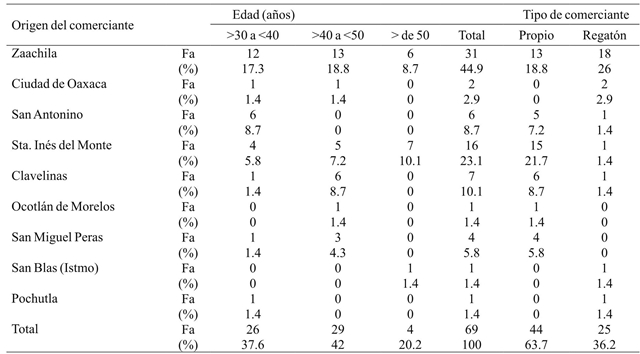
Fa= frecuencia absoluta; (%)= frecuencia relativa. Datos significativos (p=< 0.05).
Spearman’s correlation coefficient showed that the origin of the merchant is a variable that showed a statistically significant (positive) relationship with the gender, stand type, and it was significantly negative with the use they give to waste, type and trade antiquity (p≤ 0.05) (Table 3). So also the use they give to the wastes generated in this activity, is related to the origin of the merchant. Traders who come from Clavelinas, Santa Inés del Monte and San Miguel Peras, generate the least amount of waste, since the products that are not sold are destined for their own consumption (Torres, 2002; Vásquez et al., 2009) or to feed their animals. Merchants of grain and seeds are an example, mostly from Zaachila, since they do not generate any waste, as they sell their remaining grains and seeds on the next “día de plaza”.
Table 3 Spearman correlation analysis of traders selling farm produce in the “plaza” of the Villa de Zaachila.
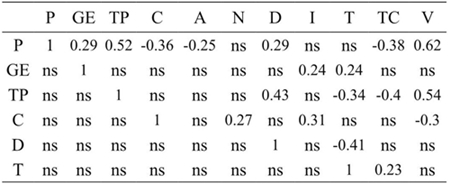
P= origen del comerciante; GE= género; TP= tipo de puesto; C= clasificación del producto que expende para fines de este estudio; A= antigüedad en el comercio; N= número de productos; D= uso del desecho; I= único ingreso; T= practica el trueque; TC= tipo de comerciante, V: vende lo mismo. ns= no significativo (p> 0.05).
The type of stand was a variable that showed a significantly negative relationship (p= 0.05) with the type of merchant (owner/haggler), the exchange of products (barter), and significantly positive if the trader sell the same products during all year. The trader type was a variable that showed a statistically negative relation with the origin and stand type; and significantly positive, with the practice of barter on “día de plaza”. The place where the peasants came from, had an effect on the activity and role they play within a traditional market, according to researchers Diskin and Cook (1975), Malinowsky and De La Fuente (1957); Tocancipá (2008) in markets of Oaxaca and Latin America.
The grouping analysis showed that, based on the variables studied, merchants originating from Villa de Zaachila are divided into two large groups around the their products commercialization. A similarity at a distance of 2 to 25% between the variables was observed. The trade antiquity was a grouping determining factor at a distance of 36% (group A and B). Similarities shared by the A, group merchants was having more seniority in commercial activity within the “plaza”. The antiquity as an agrifood merchant ranged from 48 to 65 years commercializing in this “plaza”. This variable differentiated them from the rest of the merchants (Figure 1).
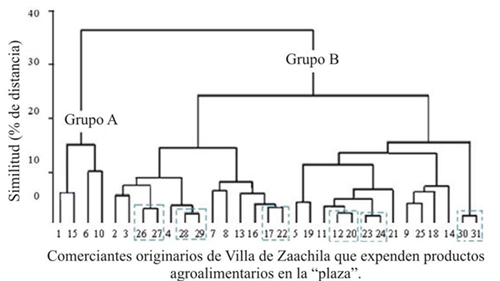
Figure 1 Similarity dendogram between 31 merchants in the “plaza” of Villa de Zaachila based on social, economic and cultural characteristics (Table 1) regarding the commercialization of their agrifood products (at a smaller distance, greater similarity).
Within group B a subdivision at a distance of 24% was identified. Traders who shared similar characteristics within group B were those using wood strips where they display their products for sale; they sell the same product throughout the year and what they can not sell on the “día de plaza” is put on sale again on the following Thursday or transformed into byproducts. Coinciding with what Malinosky and De la Fuente (1957) described about the traders who traded in other places of the region what was not sold there. Generally, they are women traders who are not accompanied by any member of their family to carry out the commercial activity. The greatest similarity was observed within group B (with 2% distance), where merchants who are 50 years old were grouped, with an antiquity between 25 and 30 years selling in this “plaza”. The characteristics they share are that this activity is their main family income, they buy other types of basic food to meet the needs of their families and sometimes barter.
Role of the family within the activities of the “día de plaza”
In family activities, women play a key role in trade, as mentioned by Zamudio et al. (2003), and especially in traditional trade (Quesada, 2012). In the “plaza” of Villa de Zaachila, 82.61% of the interviewed traders were women (Table 4). In commercial activity, husbands are the ones who cultivate the products they sell and select their crops, and women are the ones who carry out the detailed classification of products that are ready to be marketed, using their own criteria, such as size, color and maturity degree. In the case of seeds (such as peanuts and walnuts), and some native apples sold on “día de muertos”, selection begins one or two months in advance prior to its sale in the “plaza”, integrating all the family in the process.
The children of merchants only participate in the sale when they do not attend school (because there are no schoolwork on that day, or because their parents do not send them to school), or when there is a community celebration, as part of their traditions, an example is the “día de muertos”, it was observed that in each stand the children perform activities assigned by the mother, being also who makes the decisions of the haggling, quantity and price of the product on sale.
Activities on the “plaza day” around agrifood products
Marketing systems are important decision-making spaces, and they also constitute, the articulation of peasant societies (Smith, 1982), mainly for self-consumption peasants (Márquez and Martínez, 2007), these systems have existed since Prehispanic times (Carrasco, 1975; Luna, 2009) and have become a study object of anthropology and economics (Korsbaek and Barrios, 2004). In Villa de Zaachila, the “plaza” day is held on Thursdays, begins at dawn (5:00 am), merchants settle in the main streets of the town center to sell or exchange their products (Guzmán et al., 2016).
The products from their backyards are traded in quantities ranging from a few bunches to part of their annual crops, and therefore represent a social, economic and ecological importance for the farmer (González, 2013). These practices ensure their survival over time (Vásquez et al., 2009). In some cases, traders start their marketing activity one day prior to the “día de plaza” with the products selection and preparation, then they transport it to the commercial area for sale, by carts drawn by horses or mules, wheelbarrows, rental vans, depending on the product’s volume and the distance traveled by the merchant from their homes to the “plaza” (Figure 2).
Once in the “plaza”, they install the stands on the floor, in wheelbarrows, or in some small wood strips used as tables. These types of establishments are characteristic of a traditional market (Arvizú, 2013). They share some similarities with the plazas of the Valle de Tehuacán, Cuicatlán (Arellanes, 2011), the merchant of the Zaachila’s “plaza” exposes their products displayed in piles, bags, jícaras, plates and other ways. The presentation, according to other researchers (Carrasco, 1999; García, 2000; García et al., 2008; Meléndez, 2010; Londoño-Aldama, 2011), depends on the trader’s strategy in order to attract consumers, as well as what is harvested at the time (season) and the consumption habits of the population.
The products that the “owners” merchants exhibit for sale were characterized by being native to the region, that is, they are species within their origin or domestication center; they are fresh given that they are harvested at the time of sale; creoles, ie, they have been selected and adapted depending on environmental conditions (Caetano et al., 2015), and they are characterized because the agrochemical use on their products is minimal or zero, and their prices are accessible. It was identified that in this “plaza” diversity exists within the same agri-food product. The practice of two types of exchange was detected: monetary and non-monetary, with the presence of haggling, this activity is considered as an instrument through which selling can be more expensive or buying can be cheaper (Felix, 1982), is a fight for maximum benefit (Halbwachs, 1990; Monsalve, 2013) until reaching an agreement between buyer and merchant, regarding quantities and price. Both barter and haggling are marketing practices that feed the culture of a population (Pinzón and Montalvo, 2005).
Traditional measurement units used
Within this commercial activity, the measurement units are traditionally established (Warman, 1982; Arellanes, 2011; Gallardo, 2013), the measurement unit is assigned depending on the product type (Gallardo, 2013). As traditional measures in the Zaachila’s “plaza”, the piece is used, bags with a capacity of 1 kg, almud, fanega, jícara of different sizes, plate or bucket, heap, roll, bunch, third and load (Figure 3). “The measure” is the unit preconceived by the trader and the consumer. In this “plaza” it is characteristic to find more than one measurement unit for a single product (Table 5). According to Warman (1982), they are equivalence systems established by experience and tradition; Zambrano (2012) defines it as ethnomathematics applied to the market.
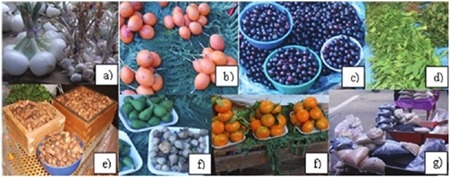
Figure 3 Various forms of products display and measurement for sale. a) roll; b) heap; c) jícara; d) bunch; e) almud; f) unicel plate; and g) kilos.
Non-monetary exchange or barter
The “owner” merchant, does not seek the maximum monetary gain, their goal is that at the end of the day all their products are completely sold. However, this is not always possible, which is why they resort to non-monetary exchange with other traders (Ferraro, 2002; Gatti, 2009); ie, barter and thus satisfy their needs primarily for food for their family (Issac et al., 2005; Orozco et al., 2008; Bonilla et al., 2013). In the “plaza” of Zaachila barter is called feriar, occasionally some traders arrive at the plaza exclusively to feriar or exchange. It was found that 66.67% of traders practice such activity (Table 6). This practice of the past that persists from pre-Hispanic markets (Diskin and Cook, 1975) represents a resistance strategy to other political and economic models such as the Free Trade Agreement (FTA) since 2004 (Tocancipá, 2008).
Table 6 Frequency analysis of the exchange of products between merchants in the “plaza” of Villa de Zaachila (sample size, n= 69).
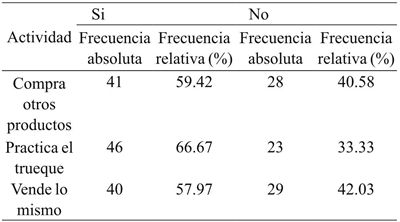
Generally, traders who come from cold-weather towns such as Santa Inés del Monte or Clavelinas, exchange their fruits like creole apple, creole pear, capulines and peaches, for other types of food such as tortillas, bread, vegetables and sometimes for firewood. This activity intensifies in the afternoon (from 3:00 pm to 5:00 pm), accompanied by “bargaining” where the price of the product decreases and the quantity increases, taking into account both the trader and the consumer, the value that the product to be exchanged has at that moment, that is to say there is no quantity or fixed price of the products.Because of this, “plazas” survive despite being in competition with other types of formal businesses such as supermarkets (Flexor, 2014).
Conclusions
At Villa de Zaachila’s “plaza”, merchants constitute two groups, owners and hagglers. The owners represent 63.7%, they are the peasants-merchants who sell their surplus in the “plaza”; the regatones represent 36.2%, they do not produce what they sell, but instead, they acquire it with the peasants of the region. 42% of traders have an age between 40 and 50 years. 44.9% of the merchants come from Villa de Zaachila and belong to the same town where this plaza is established. The origin of the merchant is significantly related to variables such as gender, stand type (floor or table), type of products on sale, antiquity in commerce, whether or not they sell the same throughout the year, and whether it is “owner” or “haggler”.
For the studied “plaza”, the marketing activities of local agrifood products can be summarized in these stages: a) product selection; b) carriage with wheelbarrows, carts or vans (own or rental); c) stand installation on the floor or table, and display of product for sale; and d) monetary or non-monetary sale. In this “plaza” the non-monetary exchange is denominated feriar (barter). In this traditional trade practice there is no quantity or fixed price for the products. The traditional measures units used in the “plaza” are piece, bags of one kilogram capacity, almud, fanega, jícara, plate, heap, roll, bunch, third and load. The product defines the measurement unit.
In this “plaza” a great diversity of agri-food products from the production systems of the region is sold. Barter and bargaining lead to strong interactions between peasants and traders who attend the “día de plaza”. Therefore, it is necessary to value and promote the consumption of local products native to the region to contribute to the strengthening of the cultural and ethnic wealth of Oaxaca state.
Literatura citada
Arellanes, C. y Casas, F. A. 2011. Los mercados tradicionales del Valle de Tehuacán-Cuicatlán: antecedentes y situación actual. Asociación Nueva Antropología. 4(74):93-123. [ Links ]
Arvizú, E. 2013. Mercados regionales de Huixcolotla y Zacapoaxtla Puebla: un enfoque de desarrollo rural. Tesis Doctoral, Colegio de Posgraduados. Montecillo Texcoco. [ Links ]
Báez, J. F. 1982. Los colores de la riqueza y la pobreza. In: mercados indios. INI-FONAPAS. México. 65 p. [ Links ]
Bellucci, S. A. 2002. La herbolaria en los mercados tradicionales. Rev. Centro Invest. 5(018-017):63-70. [ Links ]
Bonilla, A. M.; Salcido, R. B.; Paredes, S. J.; Aguirre, Á. L.; Méndez, C. M. y Hernández, R. M. 2013. La diversidad hortícola para la seguridad alimentaria en municipios marginados del estado de Puebla. Ra Ximhai. 9(2):151-163. [ Links ]
Caetano, C. M.; Peña, C., R. D.; Maigual, J.; Vásquez, D. L.; Caetano, N. D. y Pazdiora, B. R. 2015. Mejoramiento participativo: herramienta para la conservación de cultivos subutilizados y olvidados. Acta Agron. 64:307-327. [ Links ]
Carmagnan, M. 2008. La agricultura familiar en América Latina. Problemas del Desarrollo. Rev. Latinoam. Econ. 39(153):11- 56. [ Links ]
Carrasco, P. 1975. La transformación de la cultura indígena durante la colonia. Historia Mexicana. 25(2):175-203. [ Links ]
Carrasco, T. 1999. Los productores del campo en Oaxaca. Alteridades. Universidad Autónoma Metropolitana (UAM) Unidad Iztapalapa México. 9(17):95-104. [ Links ]
Castellón, M. E.; Chávez, S. J.; Carrillo, R. J. y Vera, G. A. 2012. Preferencias de consumo de chiles (Capsicum Annuum L.) nativos en los Valles Centrales de Oaxaca, México. Rev. Fitot. Mex. 35(5): 27-35. [ Links ]
Cuevas, R. V.; Espinosa, G. J.; Romero, S. F.; Jolalpa, B. J. 2008. Mercados y comercialización de insumos en la cadena de leche de vaca en el estado de Hidalgo. Rev. Mex. Agron. 12(23):631-642. [ Links ]
Diskin, M. y Cook, S. 1975. Mercados de Oaxaca. Instituto Nacional Indigenista y Secretaría de Educación Pública. México. 239 p. [ Links ]
Félix, B. J. 1982. Acciones y costumbres centenarias. In: mercados indios. INI-FONAPAS. México. 65 p. [ Links ]
Ferraro, E. 2002. Reseña de “trueque intercambio y valor: un acercamiento antropológico”. De Humphrey, C. y Hugh-Jones, S. (Comp.). Iconos. Rev. Cienc. Soc. Facultad Latinoamericana de Ciencias Sociales. Ecuador. 14:150-152. [ Links ]
Flexor, G. 2014. Las tiendas frente a la “revolución de los supermercados”: el caso de la Región Metropolitana de Río de Janeiro. Economía, Sociedad y Territorio. 14(45):497-522. [ Links ]
García, C.; Pardío, L. J.; Arroyo, A. P. y Fernández, G. V. 2008. Dinámica familiar y su relación con hábitos alimentarios. Estudios sobre las Culturas Contemporáneas. 14(027):9-46. [ Links ]
García, L. 2000. Las organizaciones de productores agrícolas en el marco del proceso de globalización económica Fermentum. Rev. Ven. Sociol. Antropol. 10(29):477-490. [ Links ]
García, M. R.; García, S. A y García, S. R. 2003. Teoría del mercado de productos agrícolas. Colegio de Posgraduados en Ciencias Agrícolas. 50-80 pp. [ Links ]
Gallardo, I. F. 2013. Sobre el comercio y mercado tradicional entre los lupaca del siglo XVI: un enfoque económico sustantivo. Chungara Rev. Antropol. Chilena. 45(4):599-612. [ Links ]
Gatti, C. 2009. El fenómeno del trueque: una mirada sociológica. Rev. Pueblos y Fronteras Digital. Universidad Nacional Autónoma de México (UNAM). 5(8):264-286. [ Links ]
González, O. F. 2013. Importancia social, económica y ecológica de la producción en traspatio, en la comunidad de san salvador Xiutetelco, Puebla. Tesis de maestría. Colegio de Posgraduados. Campus- Puebla. 164 p. [ Links ]
Guzmán, S. K del C.; Velasco, V. V. A.; Ruíz, L. J.; Campos, Á. G. V.; Rodríguez, O. G. y Enríquez, V. J. R. 2016. Productos agroalimentarios comercializados en la “Plaza” de Villa de Zaachila, Oaxaca, México. Rev. Mex. Cienc. Agríc. 7(4):871-883. [ Links ]
Halbwachs, M. 1990. Espacio y memoria colectiva. Estudios sobre las culturas contemporáneas. 3(9):11-40. [ Links ]
Ibarra, D. y Acosta, A. 2003. El dilema campesino. Investigación Económica. 62 (245):151-220. [ Links ]
INEGI(Instituto Nacional de Estadística y Geografía). 2012. Perspectiva estadística. Oaxaca. Publicación trimestral. [ Links ]
Issac, M. R.; de Jong, B.; Eastmond, A.; Ochoa, G. S.; Hernández, S. y Kntún, D. M. 2005. Estrategias productivas campesinas: un análisis de factores condicionantes del uso del suelo en el oriente de Tabasco, México. Universidad y Ciencia. 21(42):57-73. [ Links ]
Londoño, A. E. y Navas, R. M. 2011. Comercio tradicional de productos de gran consumo en Colombia: movilidad del consumidor. Orinoquia. 15(1):103-111. [ Links ]
Luna, A. A. C. 2009. Género, sociedad y cultura. Análisis multidisciplinario de las dinámicas socioeconómicas, históricas y culturales y psicológicas de las mujeres en la sierra sur oaxaqueña. Primera edición. Miahuatlán de Porfirio Díaz. Oaxaca. México. Fundación Universitaria Andaluza Inca Garcilaso. Universidad de Málaga, España. Grupo eumed.net. 106 p. [ Links ]
Malinowsky, B. y De la Fuente, J. 1957. La economía de un sistema de mercados en México: un ensayo de etnografía contemporánea y cambio social en el valle mexicano, INAH. México. 187 p. [ Links ]
Márquez, M. L. y Martínez, S. T. 2007. La combinación de sistemas agrícolas tradicionales y comerciales, el proceso de conversión en Cruz de Piedra, Estado de México. AIBR Rev. Antropol. Iberoam. 2(1):67-90. [ Links ]
Martínez, M. D.; Alvarado, F. R.; Mendoza, C. M. y Basurto, P. F. 2006. Plantas medicinales de cuatro mercados del estado de Puebla, México. Boletín de la Sociedad Botánica de México. 79:79-87. [ Links ]
Meléndez, T. J. M. y Cañez, de la F. G. 2010. La cocina tradicional regional como un elemento de identidad y desarrollo local. El caso de San Pedro El Saucito, Sonora, México. Estudios Sociales. Coordinación de Desarrollo Regional Hermosillo. México. 17(1):182-204. [ Links ]
Monsalve, M. U. 2013. “Esos cocos parecen unos limones”: estrategias discursivas de regateo usadas en el Mercado de Santa Rita (Cartagena). Cuadernos de Lingüística Hispánica. 21:41-54. [ Links ]
Orozco, C. S.; Jiménez, S. L.; Estrella, C. N.; Ramírez, V. B.; Valeriano, P. B.; Ramos, S. A.; Morales, G. M. 2008. Escuelas de campo y disponibilidad alimentaria en una región indígena de México. Estudios Sociales. 16(32):7-26. [ Links ]
Pinzón, G. A. y Montalvo, C. I. 2005. El regateo como expresión cultural en Barranquilla, Colombia: caso Shopping Center y Miami. Pensamiento y Gestión. 19:200-244. [ Links ]
Pool, I. E. e Illsley, G. C. 2012. El papel de los activos culturales en las dinámicas territoriales rurales: el caso de Tlacolula y Ocotlán en Valles Centrales de Oaxaca, México. Proyecto Desarrollo Territorial Rural con Identidad Cultural (DTR-IC). Centro Latinoamericano para el Desarrollo Rural. 56 p. [ Links ]
Quesada, M. E. 2012. La perspectiva de género en el comercio justo: una reflexión económico antropológica. Revista Pueblos y Fronteras Digital. 7(14):81-116. [ Links ]
Smith, C. A. 1982. El estudio económico de los sistemas de mercado: modelos de la geografía económica. Nueva Antropología. 6(19):29-80. [ Links ]
Tocancipá, F. J. 2008. El trueque: tradición, resistencia y fortalecimiento de la economía indígena en el Cauca. Revista de Estudios Sociales. 31:146- 161. [ Links ]
Torres, G. L. 2002. Autoconsumo y reciprocidad entre los campesinos andinos: caso Fómeque. Cuadernos de Desarrollo Rural. 48:78-98. [ Links ]
Vásquez, S. V.; Vizcarra, B. I.; Quintanar, G. E. y Lutz, B. B. 2009. Heterogeneidad en las prácticas agrarias como estrategia de adaptación a los procesos globales. Caso de Santa Cruz (Chilapa, Guerrero, México). Convergencia. 16(50):79-106. [ Links ]
Warman, A. 1982. Acciones y costumbres centenarias. In: mercados indios. INI-FONAPAS. México. 65 p. [ Links ]
Zambrano, A. J. 2012. Prácticas matemáticas en una plaza de mercado. Rev. Latinoam. Etnom. 5(1):35-61. [ Links ]
Zamudio, B. A.; Alberti, M del P.; Manzo, F.; y Sánchez, M. T. 2003. La participación de las mujeres en los sistemas de traspatio de producción lechera en la ciudad de México. Cuadernos de Desarrollo Rural. 51:37-60. [ Links ]
Received: February 2017; Accepted: May 2017











 texto em
texto em 

